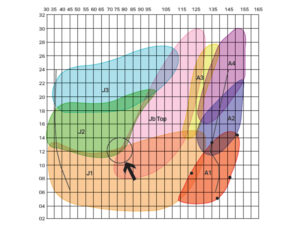Sunday was a fairly forgettable day of frostbiting for yours truly. Actually, that’s probably the wrong way to look at it. As much as I’d like to forget about it, there was quite a few lessons to be learned from my mistakes, which ranged from drysuit zipper issues, which caused me to miss a race, to flipping twice, once because I hooked my mainsheet on a winter mooring stick. So perhaps forgettable is the wrong word. Regrettable might be better.
Ironically enough, however, the lesson that stuck with me the most comes from something that went right.
The last race of the day was a two-lapper. The first lap was a standard windward-leeward, the second, a Harry Anderson (windward, reach mark, committee boat to starboard, leeward, finish). On the long second upwind leg, I was locked into a three-way battle for fourth, grunting and grinding through a breeze that had picked up into the mid teens. The top three boats we were well ahead, and the remaining competition wasn’t really a concern. About three-quarters of the way up the beat, I was on starboard, with one rival well to leeward, and one just on top of me.
A puff hit and I sensed it had a bit of left shift in it, so I tacked to port. The boat above me followed suit, though he was probably a touch late for a perfect cover. Nonetheless, I needed to make a decision. My gut reaction was to tack and clear my air. But I felt I was going the right way. So I sailed low and fast for 10 seconds to get out of his dirty air, then sheeted back on, one boatlength to leeward and a half boatlength back of his position.
As we closed on the starboard layline, I had to make another decision. I didn’t want to simply follow him out to the layline, wait for him to tack, then follow him into the mark. That would lock me into being 3 boatlengths behind at the mark. Plus I’d be as his mercy. He could overstand just to make it hurt. And I didn’t want to forget about the other boat, coming in from the left. I’d made a small gain on the top left of the beat in a previous race. I thought that might be there again (many of the shifts on our frostbite course have a geographic component to them). And I knew that from where we were, it would be tough to nail the layline in the bumpy, gusty conditions.
So I waited until we were close enough to the starboard layline—5 boatlengths or so, in this case—that the boat on top of me would probably decide that a tight cover wasn’t worth the two extra tacks.
I tacked, he didn’t, and I was able to sail, in clear air, until I was two lengths or so from the port layline. Then I tacked back. The boat coming in from the left was still a few lengths behind me. And I’d closed on the guy on the right. Better yet, he’d undershot the layline. So I was able to sail a bit past his line and tack, finishing it just in time to see his boom clip the mark. His frustration was music to my ears.
I rounded, sheeted out for the reach, and took off on a wave. By the time I looked behind, I had a good 20-length lead on the next boat, which enabled me to sail a bit more conservatively on the reaches and the run and record the fourth, my best finish of the day.
Of course, you can’t always depend on your opponent hitting the mark. Then again, my goal wasn’t necessarily to pass him there. We still had two reaches, a short run, and then a beat to the finish. My goal was to chip away, carve off a boatlength or two, keep the pressure on.
But by tacking away before the layline, I forced him to nail his layline call. If he called it fat, I might’ve been able to sneak inside and get room around the mark. Calling it thin, as he did, meant risking hitting the mark.
The other key decision was not to tack when he covered me. With a small fleet, sailing in bad air is always tough to stomach. Everyone else is sailing free. However, sometimes it’s better than sailing on the headed tack. Had his slam-dunk been a little more aggressive, I might’ve had no choice but to tack. But as it turned out, I knew I could get though his bad air quickly, stay on the favored tack, and keep control of my race.









